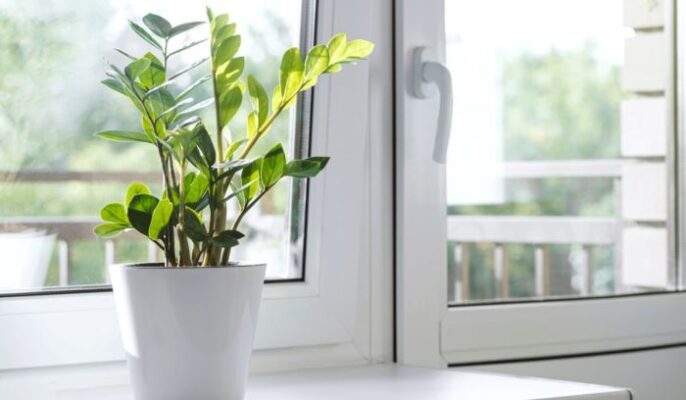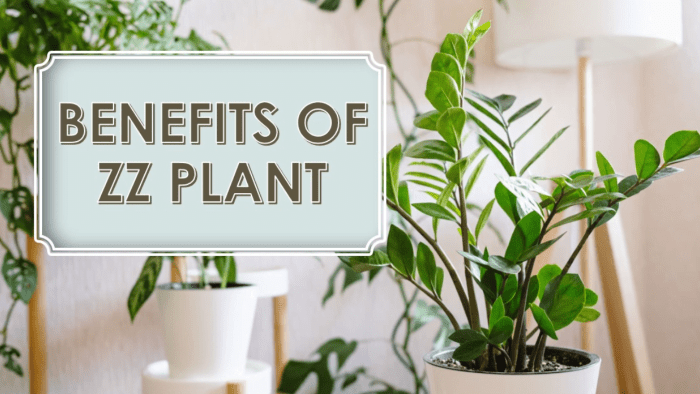The ZZ Plant (Zamioculcas zamiifolia) is a popular low-maintenance indoor plant known for its shiny, leathery leaves and ability to thrive in low light. This attractive plant is native to eastern Africa and is characterized by its thick rhizomes and oval-shaped dark green leaves. In this article we talk about ZZ Plant Care Tips – Low-Maintenance Indoor Plant Benefits and Advice.
ZZ plants are extremely easy to care for, making them an excellent choice for beginner gardeners or those with busy schedules who want an unfussy houseplant. They adapt well to a wide range of indoor conditions, require little watering, and are resistant to pests. Read on for tips on caring for your ZZ plant so it remains healthy and beautiful in your home for years to come.
Table of Contents
Light Requirements

ZZ plants do well in medium to low, indirect light. They can tolerate shady corners and north-facing windowsills. Too much direct sun will scorch their leaves, so avoid placing them in south or west-facing windows unless you use a sheer curtain to filter the light. The stems may start to stretch and lean if they don’t get enough light, but you can prune them back to reshape the plant. In general, bright indirect light is best for the ZZ plant.
Tip: Rotate the plant occasionally to ensure even light distribution and prevent uneven growth.
Watering
One of the ZZ plant’s best qualities is its tolerance for drought and irregular watering. Overwatering is more likely to damage this plant than underwatering it. Allow the soil to dry out completely between waterings, checking with your finger about one inch deep to see if moisture remains. The pot should feel light when lifted, indicating it’s a good time to water. Water thoroughly until it drains from the bottom, then dump out any excess from the saucer so the plant isn’t left sitting in standing water.
Tip: Use a moisture meter to accurately gauge soil dryness and prevent overwatering.
During the winter months when growth slows, the ZZ plant may only need water every 3-4 weeks. Reduce watering frequency in darker rooms as well. If leaves start to yellow and drop, you may be overwatering. Allow the soil to dry out for a week or two before resuming your normal watering routine. Proper drainage is key for ZZ plants, so always use containers with holes and well-draining soil mixes.
Tip: Ensure the saucer under the pot is empty after watering to prevent water from sitting and causing root rot.
Soil and Fertilizer
ZZ plants grow well in standard potting soil mixes. You can also amend regular potting mix with perlite, coarse sand, or orchid bark to improve drainage. Avoid soil mixes that have moisture-retaining peat or compost. When potting or repotting ZZ plants, choose a container that’s one size larger than the current roots allow. Shallow pots work better than deep containers.
Tip: Test soil drainage by watering until it runs out of the pot; if it drains slowly, amend the soil with additional perlite or sand.
Feed ZZ plants monthly during the growing season (spring through summer) with a balanced liquid fertilizer diluted to half strength. Fertilizing is unnecessary in the winter when growth slows. As an alternative to chemical fertilizers, you can use compost tea or organic granular fertilizer a couple times a year.
Tip: Fertilize after watering to reduce the risk of root burn and ensure better nutrient absorption.
Temperature and Humidity
ZZ plants thrive in average home temperatures between 60-80°F. Keep them away from cold drafts in winter as well as hot spots near heaters, fireplaces, or appliances. Higher humidity is beneficial but not essential. You can boost moisture in the air around ZZ plants by placing their pots on pebble trays filled with water or misting their leaves occasionally with a spray bottle. Just be careful not to overwater the soil.
Tip: Use a hygrometer to measure humidity levels and ensure they remain within the optimal range for your ZZ plant.
Pruning
To keep your ZZ plant full and shapely, prune off any dead or damaged leaves at the base of the stem. If the stems become lanky and unattractive, cut them back to just above the rhizome. This will encourage bushier new growth. You can also divide congested ZZ plants by carefully breaking apart the rhizome sections and repotting them individually. Try to retain some roots and leaves on each division.
Tip: Prune in spring or early summer for the best recovery and new growth.
Propagation
Propagating ZZ plants is straightforward. The easiest method is division, as described above – simply divide the rhizomes when repotting. You can also take 3-6 inch stem cuttings, allowing them to dry for 1-2 days before inserting into soil. Remove lower leaves and place in a warm, bright spot until new growth emerges.
Tip: Use rooting hormone for faster root development when propagating from cuttings.
Leaf cuttings are another option: cut off a healthy leaf then insert the petiole (leaf stalk) into well-draining soil. Keep warm and moist until new shoots appear. Rooting hormone can speed up the process but isn’t necessary. Be patient, as propagating ZZ plants from leaves or stems may take a couple months.
Tip: Cover the pot with a plastic bag or dome to create a mini greenhouse effect and retain moisture while propagating.
Common Problems
ZZ plants have very few pest or disease issues. Their main problems are related to overwatering, low light, or cold drafts. Yellowing leaves usually indicate too much moisture around the roots leading to root rot. Allow the soil to completely dry out before watering sparingly. Drooping leaves can mean either too little light or underwatering. Check the soil moisture and move the plant if necessary.
Tip: Inspect the plant regularly for pests like spider mites and treat them promptly to prevent infestations.
Spider mites may occasionally be an issue if humidity is very low. You’ll see fine webbing and stippling damage on the leaves. Wipe leaves down with a wet cloth to remove mites and webs, and spray neem oil as needed. Ensure the plant gets adequate indirect light and moisture. Proper care should keep your ZZ thriving and free of most problems.
Benefits of ZZ Plants
There are many great reasons to add a ZZ plant to your indoor plant collection:
| Benefit | Description |
|---|---|
| Extremely low maintenance and hard to kill | ZZ plants require minimal care and are resilient. |
| Tolerates low natural light and infrequent watering | Can thrive in low-light conditions and with irregular watering. |
| Produces attractive, sculptural foliage | Features visually appealing, unique leaves. |
| Great for beginners or busy/traveling plant owners | Ideal for those new to plants or with a hectic lifestyle. |
| Filters indoor air pollutants like formaldehyde | Helps improve indoor air quality. |
| Unfussy nature means very few pest or disease issues | Rarely affected by pests or diseases. |
| Adds lush, tropical look to desks, shelves, or floors | Enhances decor with its vibrant, tropical appearance. |
| Can be kept compact or grown into a large, bushy floor plant | Versatile size options to suit different spaces. |
| Interesting rhizome root system to divide and propagate | Allows for easy propagation through its unique roots. |
With proper ZZ plant care following the tips above, you’ll have a beautiful and resilient houseplant that thrives for years with minimal effort on your part. The ZZ plant is a top choice for gift-giving too due to its durability and exotic look. Place it in a bright bathroom, low-light office, or any room needing a shot of nature with this adaptable, pet-friendly green friend. I sincerely hope you find this “ZZ Plant Care Tips – Low-Maintenance Indoor Plant Benefits and Advice” article helpful.
If you enjoyed this article, you might also like this one: Alocasia Black Velvet

